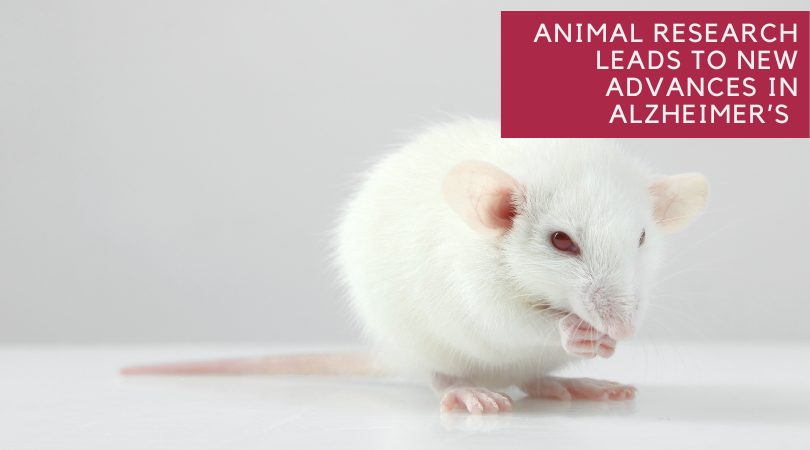Animal Research Leads to New Advances in Alzheimer’s
Posted on
As of 2023, an estimated 6.7 million Americans are living with Alzheimer’s disease. Without a significant scientific breakthrough to cure or prevent the disease, that number is projected to double by 2050. Scientists all over the world are striving to achieve such breakthroughs, with animal research offering several promising avenues.
Light Therapy as Alzheimer’s Treatment
A study at the University of Virginia has discovered that light therapy might have potential as a treatment for Alzheimer’s disease.
Sleep is essential to clear toxic debris out of the brain, like the amyloid proteins that are a hallmark of the disease. Alzheimer’s patients often struggle to fall or stay asleep, and these circadian rhythm disruptions are a major reason why Alzheimer’s patients eventually require total care. Poor sleep quality has also been identified as a risk factor for Alzheimer’s.
The UVA study found that people who are more sensitive to light may be more likely to experience sleep disruptions and “sundowning,” a phenomenon in which Alzheimer’s symptoms worsen later in the day.
The UVA team used mouse models of Alzheimer’s to test whether changing their exposure to full-spectrum light would promote normal brain function. The researchers used light exposure patterns to induce a form of “jet lag” in Alzheimer’s and control mice, then observed how it affected their behavior.
The Alzheimer’s mice adapted to the six-hour time change much more quickly than the control mice, indicating that the Alzheimer’s mice are more sensitive to light. This opens up the possibility that light therapy may help alleviate the sleep-related disruptions associated with Alzheimer’s and slow the progression of the disease.
Stem Cell Transplants
Stem cell transplantation is a revolutionary technology that has been used to treat everything from cancer to organ rejection. Now, researchers from the University of California San Diego have discovered a specific type of stem cell transplant that can protect against memory loss, neuroinflammation, and beta-amyloid build-up in mouse models of Alzheimer’s.
The team transplanted healthy hematopoietic (bone marrow) stem cells into mouse models of Alzheimer’s. The treated mice showed better cognitive functioning than Alzheimer’s mice that did not receive the stem cell treatment, and memory loss and neuroinflammation were completely prevented in the stem cell mice. The mice that received the stem cells also showed significantly less beta-amyloid plaque buildup in the brain.
The discovery could lead to stem cell therapy to prevent complications from Alzheimer’s and slow the progression of the disease.
In a separate study, researchers at Stanford University were able to use stem cell transplantation to reduce the brain abnormalities common in Alzheimer’s disease.
The team transplanted blood stem and progenitor cells into mice in an effort to replace defective microglia, a type of neural cell that is impaired in mouse models of Alzheimer’s.
Microglia are thought to play a more significant role in nonfamilial cases of Alzheimer’s disease—those not due to a mutated gene variant. Microglia cells protect other brain cells and clear the brain of toxic debris. Impaired microglia function can lead to neurodegeneration in the brain.
Separately, researchers at The Picower Institute for Learning and Memory at MIT recently discovered a rare genetic mutation called TREM2 R47H/+ that undermines microglia function and increases Alzheimer’s risk.
In the Stanford study, after the stem cell transplant, most of the dysfunctional microglia cells in the brains of the Alzheimer’s mice were replaced with healthy cells that looked and behaved like normal microglia cells. The mice showed improved cognitive functioning and a reduction in amyloid plaque accumulation.
The Renewed Hunt for an Alzheimer’s Vaccine
Most Alzheimer's research has focused on causes, potential treatments, and a range of prevention factors, but the most effective way to address the Alzheimer’s epidemic would be to prevent people from getting it in the first place.
The last promising Alzheimer’s vaccine candidate was developed more than two decades ago, but it was abandoned when 6% of human clinical trial volunteers developed life-threatening brain inflammation.
Now, a handful of new Alzheimer’s vaccines are in various stages of testing, including one developed by a research team at the Juntendo University Graduate School of Medicine in Tokyo.
Tested with mouse models of Alzheimer’s, the new vaccine targets cells that express the SAGP protein, which go into production overdrive in those with Alzheimer’s disease, resulting in a buildup of amyloid plaque deposits and other symptoms of the disease.
By reining in SAGP overproduction, the vaccine is designed to slow down Alzheimer’s or even completely stop the progression of the disease.
Two groups of Alzheimer’s mice were inoculated with either the vaccine or a placebo. The mice that received the vaccine displayed significantly better performance in a maze test than the control mice, and showed improved mental awareness. Lab tests on brain tissues of the vaccinated mice showed reduced amyloid deposits.
A Bodybuilding Supplement with an Excellent Side Effect
Any treatment for Alzheimer’s must go through a rigorous, years-long testing process to ensure it is safe for human consumption. But one new potential treatment for Alzheimer’s has a huge advantage—it is already considered safe, and you can get it over the counter at your nearest Walmart.
Researchers at Rush University and Simmaron Research are exploring the potential of the bodybuilding supplement beta-hydroxy beta-methylbutyrate (HMB) to prevent cognitive decline in mice.
The team found that mice who received HMB orally demonstrated improved learning and memory, as well as reduced plaque build-up in the brain.
The team hopes HMB can be used to fight dementia